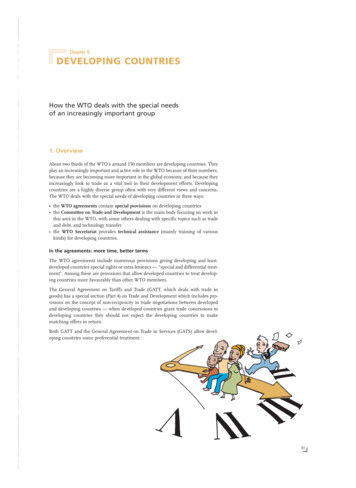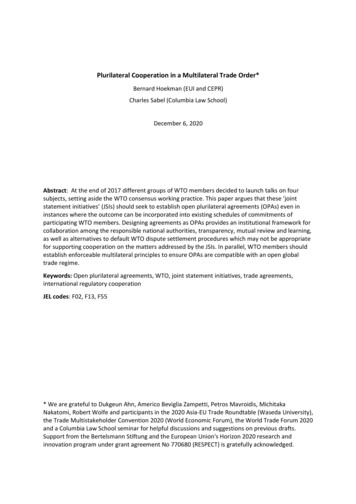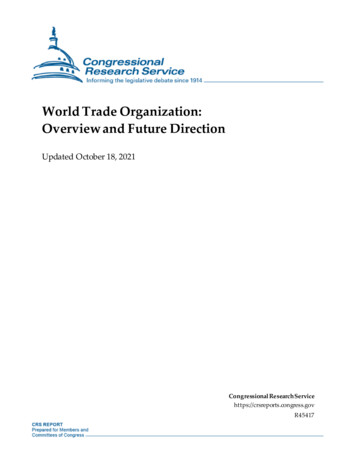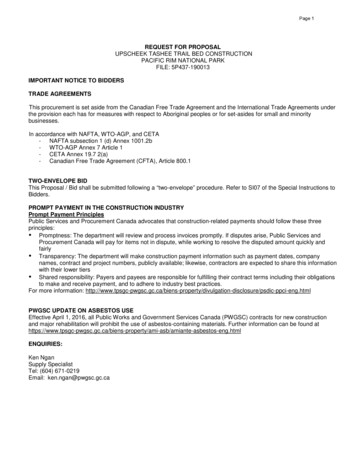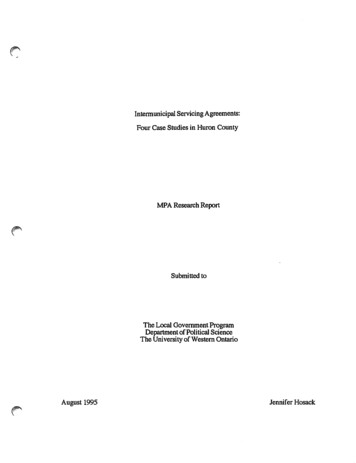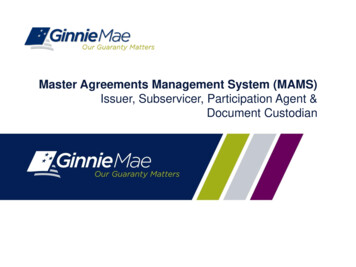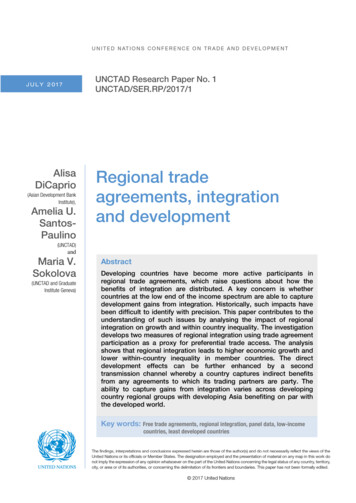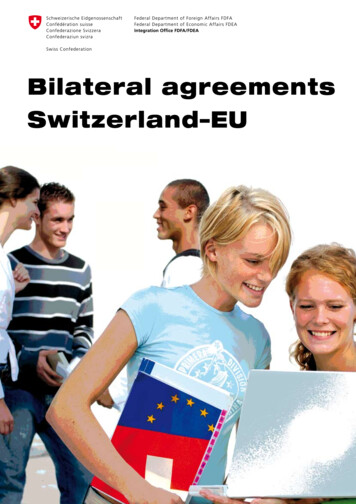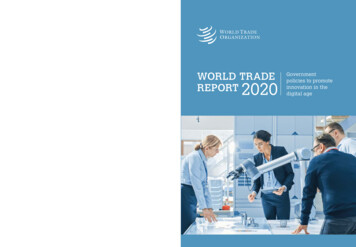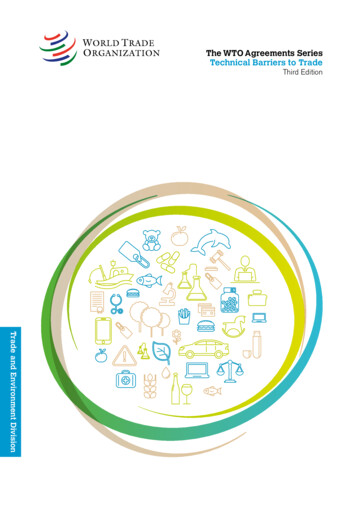
Transcription
The WTO Agreements SeriesTechnical Barriers to TradeThird EditionTrade and Environment Division
The WTOagreements seriesThe WTO’s agreements are the legal foundation for the international trading system that isused by the bulk of the world’s trading nations. This series offers a set of handy referencebooklets on selected agreements. Each volume contains the text of one agreement, anexplanation designed to help the user understand the text, and in some cases supplementarymaterial. They are intended to be an authoritative aid for understanding the agreements, butbecause of the legal complexity of the agreements, the introductions cannot be taken aslegal interpretations of the agreements.The agreements were the outcome of the 1986–1994 Uruguay Round of world tradenegotiations held under the auspices of what was then the GATT (the General Agreementon Tariffs and Trade). The full set is available in The WTO Agreements: The MarrakeshAgreement Establishing the World Trade Organization and its Annexes. It includes about60 agreements, annexes, decisions and understandings, but not the commitments individualmembers made on tariffs and services.The volumes in this seriesAgreement Establishing the WTOAgricultureGATT 1994 and 1947Sanitary and Phytosanitary MeasuresTechnical Barriers to Trade
ContentsIntroduction 3The basic structureof WTOagreements5The TBT Agreement9OverviewKey principles TransparencyQuality infrastructure Disputes brought under the TBTAgreement920384850Agreementon TechnicalBarriers to Trade(the legal text)53Technical Barriers to Trade1
Decisions and recommendationsadopted by theTBT Committeesince1 January 1995Observersin the TBTCommitteeList of abbreviations List of boxes, figures and tablesDisclaimerThis work is published under the responsibility ofthe WTO Secretariat. The opinions expressed andarguments employed herein do not necessarilyreflect the opinions or views of WTO members.2WTO Agreements Series77189190191
IntroductionThe WTO Agreement on Technical Barriers to Trade (TBT Agreement) entered into forcewith the establishment of the World Trade Organization (WTO) on 1 January 1995. It aimsto ensure that product requirements in regulations and standards (on safety, quality, health,etc.), as well as procedures for assessing product compliance with such requirements(testing, inspection, accreditation, etc.), are not unjustifiably discriminatory and/or do notcreate unnecessary obstacles to trade.This handbook discusses the text of the TBT Agreement as it appears in the Final Act ofthe Uruguay Round of Multilateral Trade Negotiations (Final Act), signed in Marrakesh on15 April 1994. The various WTO multilateral agreements (including the TBT Agreementand the amended General Agreement on Tariffs and Trade (GATT 1994)), as well as afew plurilateral agreements, are all contained in the Final Act. The Final Act, in turn, ispart of the treaty that established the WTO: the Marrakesh Agreement Establishing theWorld Trade Organization (WTO Agreement). The WTO superseded the GATT 1947 asthe umbrella organization in charge of multilateral trade.The WTO Secretariat has prepared this handbook to assist public understanding of theTBT Agreement. The handbook first presents the basic structure of WTO agreements. It thenprovides a brief overview of the background, purpose and scope of the TBT Agreement, aswell as the types of measures it covers. It sets out the key principles of the TBT Agreementand discusses how these have been addressed in recent key disputes brought underthis Agreement. Next, it focuses on transparency, a cornerstone of the TBT Agreement.It also describes the mandate, role and work of the TBT Committee, and considers howTBT‑related matters have arisen in negotiations at the WTO. The handbook also containsthe full text of the TBT Agreement, a compilation of decisions and recommendations bythe TBT Committee over the years and a list of observers in the TBT Committee. Standards and regulations are among the mostimportant types of trade-related measures usedaround the world. Crafting them carefully, in linewith the disciplines of the WTO Agreement onTechnical Barriers to Trade, can help governmentsachieve important policy objectives, includingsafeguarding human health and safety, as wellas protecting the environment – and this withoutunnecessarily disrupting trade. This Handbook isa must-read for anyone interested in these issues,including policy-makers, practitioners, the privatesector, consumers and academia. Alan Wm. WolffDeputy Director-General of the WTOTechnical Barriers to Trade3
The basic structureof WTO agreementsThe conceptualframeworkBroadly speaking, the WTO agreementsfor the two largest areas of trade – goodsand services – share a common threepart outline, even though the details aresometimes different (see Figure 1).They start with general disciplines containedin the GATT (for goods), the GeneralAgreement on Trade in Services (GATS)(for services) and the Agreement on TradeRelated Aspects of Intellectual PropertyRights (TRIPS) (for intellectual property).Figure 1: The basic structure of the WTO agreementsUmbrellaAGREEMENT ESTABLISHING THE WTOGoodsServicesIntellectualpropertyBasic principlesGATTGATSTRIPSAdditional detailsOther goodsagreements andannexesServices annexesMarket accesscommitmentsCountries’schedules ofcommitmentsCountries’schedules ofcommitments (andMFN exemptions)Dispute settlementDISPUTE SETTLEMENTTransparencyTRADE POLICY REVIEWSTechnical Barriers to Trade5
Then come additional agreements andannexes dealing with the special requirementsof specific sectors or issues. These deal withthe following:For goods (under GATT)AgricultureSanitary and phytosanitary regulationsfor food safety, animal and plant healthprotection (SPS)Textiles and clothingTechnical regulations andstandards for products (TBT)Trade-related investment measuresAnti-dumping measuresCustoms valuations methodsPre-shipment inspectionRules of originImport licensingSubsidies and countervailing measuresSafeguardsTrade facilitationFor services (the GATS annexes)Movement of natural personsAir transportFinancial servicesShippingTelecommunicationsFinally, there are the detailed and lengthyschedules (or lists) of commitments made byindividual members allowing specific foreignproducts or service providers access to theirmarkets. For the GATT, these take the formof binding commitments on tariffs for goodsin general, and combinations of tariffs andquotas for some agricultural goods. For theGATS, the commitments state how muchaccess foreign service providers are allowed6WTO Agreements Seriesfor specific sectors, and they include lists oftypes of services where individual memberssay they are not applying the most-favourednation (MFN) principle of non- discrimination.Much of the Uruguay Round dealt withthe first two parts: general disciplines anddisciplines for specific sectors. At the sametime, market access negotiations werepossible for industrial goods. Once theprinciples had been worked out, negotiationscould proceed on the commitments forsectors such as agriculture and services.Negotiations after the Uruguay Round andbefore the beginning of the Doha Roundin 2001 focused largely on market accesscommitments: financial services, basictelecommunications, maritime transportation(under the GATS), and information technologyequipment (under the GATT).The agreement in the third area of tradecovered by the WTO – on intellectualproperty (IP) – covers general IP disciplines,as well as disciplines covering specific IPareas, such as copyright, patents, trademarksand geographical indications. Other detailscome from conventions and agreementsoutside the WTO.The agreement on dispute settlementcontains specific procedural disciplines onhow to conduct WTO disputes, while theTrade Policy Review Mechanism aims toensure that WTO members’ trade policiesand practices are transparent.Also importantOne other set of agreements not includedin Figure 1 is also important, that is, thetwo plurilateral agreements not signedby all members – fair trade in civil aircraftand government procurement. (Originallythere were four agreements, but thoseconcerning dairy products and bovine meatwere terminated at the end of 1997.)
The legalframeworkThe conceptual structure is reflected inthe way the legal texts are organized. Theshort WTO Agreement sets up the legal andinstitutional foundations. Attached to it is amuch lengthier set of four annexes. Annex 1 contains most of the detailedrules, and is divided into three sections:– 1A, containing the revised GATT,the other agreements governingtrade in goods and a protocol thatties in individual members’ specificcommitments on goods.– 1B, the GATS, texts on specific servicessectors and individual members’specific commitments and exemptions.Collectively, the agreements included inAnnex 1 are referred to as the multilateraltrade agreements since they comprise thesubstantive trade policy obligations that allthe members of the WTO have accepted. Annex 2 sets the rules and procedures fordispute settlement. Annex 3 provides for regular reviews ofdevelopments and trends in national andinternational trade policy. Annex 4 covers the plurilateral agreementsthat are within the WTO framework, butwhich have limited membership.Finally, the Marrakesh texts include a numberof decisions and declarations on a widevariety of matters that were adopted at thesame time as the WTO Agreement itself.– 1C, the TRIPS Agreement.Technical Barriers to Trade7
The TBT AgreementOverviewBackground and purposeThe TBT Agreement entered into force on1 January 1995. It is one of the various WTOagreements annexed to the WTO Agreement.As indicated above, the TBT Agreementbelongs to the family of multilateral WTOagreements dealing with trade in goods (theGATT and the Agreement on the Applicationof Sanitary and Phytosanitary Measures(SPS Agreement) are examples of other“goods” agreements).The TBT Agreement was not, however,the first one to discipline technical barriers(standards and regulations) to internationaltrade in goods. In fact, the TBT Agreementwas built upon the provisions of a previousGATT agreement that had been in operationfor 15 years by the time the WTO was createdin 1995: the 1979 Tokyo Round Agreement onTechnical Barriers to Trade (commonly knownas the Standards Code). As a plurilateralagreement, however, the Standards Code wasmade up from only a subset (46) of all GATT“contracting parties” (128).1The TBT Agreement is a WTO MultilateralTrade Agreement. This means that,unlike the 1979 Standards Code, theTBT Agreement is binding on all, not justsome, WTO members.2 All WTO MultilateralTrade Agreements – including theTBT Agreement – are part of a coherent“single undertaking” administered underthe umbrella of the WTO. This is why theTBT Agreement and all other multilateralagreements share the same fundamentalprinciples, including non‑discrimination,promoting predictability of access tomarkets, and technical assistance (TA) andspecial and differential (S&D) treatment fordeveloping members.However, as a specialized “goods” agreement,the TBT Agreement also includes featuresspecific to the preparation, adoption andapplication of regulatory measures thataffect trade in goods. For instance, theAgreement strongly encourages regulatoryharmonization by requiring, when possible,the use of international standards. TheAgreement also requires members to avoidadopting regulations that restrict tradebeyond what is necessary to address thestated policy objective (health, environment,etc.). This obligation applies regardlessof whether the regulation is or is notdiscriminatory. Moreover, the Agreementcontains detailed provisions to clarify andincrease transparency throughout theentire process of preparing, adopting andapplying TBT measures (the regulatorylifecycle). These provisions – together withTBT Committee guidance developed bymembers in a step-by-step fashion over theyears – have enabled the TBT Agreementto become a unique multilateral instrumentfor addressing trade‑related regulatorymeasures on goods.The TBT Agreement is part of a broadercategory of WTO agreements dealingwith non-tariff measures (NTMs). Theterm NTMs encompasses all measuresthat affect (actually or potentially) trade,Technical Barriers to Trade9
other than tariffs. NTMs – which includetechnical regulations, standards andconformity assessment procedures (CAPs)(the three types of measures covered by theTBT Agreement) – present the internationaltrading system with several challenges. Onthe one hand, governments frequently relyon NTMs to achieve public policy goals (e.g.protecting human health or the environment):the fact that trade is affected is a normal andlegitimate consequence of such regulatoryprocesses. On the other hand, NTMscan sometimes be unnecessarily traderestrictive and/or unjustifiably discriminatory.In addition, NTMs are often technicallycomplex, less transparent and more difficultto quantify than tariffs, and can thereforehave a significant impact on market access.The main challenges to trade thereforerelate not to addressing “why” governmentsregulate, but to “how”.The TBT Agreement was carefully designedwith these challenges in mind. Its disciplinesaddress the “how” by helping WTOmembers distinguish between, on the onehand, regulatory measures with “legitimate”motivations and proportional requirements,and, on the other hand, measures with“protectionist” and arbitrary trade effects.As such, the Agreement is an importanttool to improve coherence and mutualsupportiveness between open trade, onthe one hand, and the domestic policiesthat countries use to achieve public policyobjectives, on the other. In short, the disciplinesof the TBT Agreement are intended to helpgovernments achieve a balance betweenupholding legitimate regulatory policyobjectives (e.g. the protection of human andanimal life and health and the protection of theenvironment) and respecting key disciplinesin the Agreement (e.g. non‑discrimination,avoidance of unnecessary barriers to tradeand use of international standards as a basisof technical regulations, where possible) (seeFigure 2).Figure 2: Purpose of the TBT es tointernational trade10WTO Agreements SeriesPreserving members’right to regulateto protectlegitimate interests
The scope of the TBT AgreementThe TBT Agreement contains variouscriteria relevant for defining its scope. Oneset of criteria concerns what subject‑matteris excluded from the Agreement. TheAgreement expressly states that it does notapply to measures: on services;3 for government procurement purposes;4and covered by the SPS Agreement (sanitaryand phytosanitary measures).5Except for the above exclusions, theTBT Agreement in principle covers a broadcategory of NTMs affecting internationaltrade. The Agreement governs domesticmeasures regulating products, either in termsof their “characteristics” (what they must ormust not be made of, their packaging orlabelling, etc.) or in terms of their “processesand productions methods” (how they aremade or produced). TBT measures canpursue a wide variety of policy objectives,such as health and safety, as well as theprotection of the environment.The full scope of the TBT Agreement issometimes not well understood. And, aswe shall see further below, this can haveimportant implications, in particular, forunderstanding precisely the boundariesbetween the TBT and SPS Agreements.A common misunderstanding, for instance,is that the TBT Agreement only coversregulations on the labelling or packaging (orthe quality and performance) of industrialproducts and consumer durable goods:cars, trains, computers, bicycles, householdappliances, furniture and so on. While it isindeed true that the Agreement deals withthese types of measures, its scope is wider.Here are three reasons why.First, in terms of product coverage, asexpressed in Article 1.3, all products – includingindustrial and agricultural products – are subjectto the provisions of the TBT Agreement. Thismeans that a measure cannot automaticallyfall outside the TBT Agreement’s scope justbecause it is a regulation about certain kindsof products, for example, foods or agriculturalgoods (e.g. corn, sardines, oranges, coffee,poultry or livestock).Second, the same is true in terms of theobjective(s) pursued. A measure cannotbe automatically excluded from theTBT Agreement’s scope just because itaddresses a particular type of policy objective(at least when objectives are describedin broad terms, for example, as being theprotection of human life or animal health).Instead, here too, the Agreement’s scope iswide: it covers regulatory measures fulfillinga wide range of “legitimate objectives”.No objective is, a priori, “carved out” fromthe Agreement (except, as we shall seebelow, those that are explicitly covered bythe SPS Agreement). The TBT Agreementexpressly mentions some types of objectives(quality; protection of human, animal or plantlife or health; protection of the environment;prevention of deceptive practices, etc.),but this is a non-exhaustive list. And theTBT Agreement describes such objectives invery broad terms (as we shall see below, thisis a key distinction with the SPS Agreement,which describes the objectives or purposes ofSPS measures very specifically – and theseare excluded from the TBT Agreement’scoverage).Third, another element – indeed the mostimportant – is the identification of the “type” ofmeasure. Here, in contrast with the other criteriaabove, the TBT Agreement is specific andTechnical Barriers to Trade11
exhaustive. It only covers three types of strictlydefined measures: technical regulations,standards and CAPs (more on this terminologybelow). The implication of having such precisedefinitions is clear: if a measure does not meetany of them, it cannot be a TBT measure.And if this is the case, then such measurewill always fall outside the scope of theAgreement, regardless of its product coverageor the objective(s) it pursues.Relation to the SPS AgreementThe TBT and SPS Agreements are very closein many aspects. For starters, both are partof the family of WTO covered agreementsabout trade in goods (a well-known memberof this family being the GATT). More thanthat: generally speaking, the TBT andSPS Agreements both cover regulatory (nontariff) measures addressing issues such ashuman or animal health. They contain similarobligations (for example, non‑discrimination,use of international standards, enhancedtransparency, etc.). The Agreements, onthe other hand, also differ in many otherimportant aspects, and not only in terms ofsome unique obligations each contain, butalso (and importantly) concerning the waythey define their coverage.Given such a unique relationship, delineatingthe boundaries between these twoagreements may sometimes be difficult. Thisis a particularly important question becausethe TBT Agreement does not apply toSPS measures (TBT Agreement, Article 1.5),while the SPS Agreement cannot affectmembers’ rights under the TBT Agreementconcerningallnon‑SPSmeasures(SPS Agreement, Article 1.4). As theexamples below illustrate, regulations withconcurrent TBT and SPS elements requirespecial attention. For example, sometimesWTO members may need to fulfil their12WTO Agreements Seriestransparency obligations under one orboth agreements (and can also raise anytrade concerns under the SPS and/or theTBT Committees) depending on the specificobjectives and elements of a measure.Turning to explore the similarities anddifferences between the TBT andSPS Agreements, note that the key elementfor defining the scope of the SPS Agreementis the purpose of the measure. This is criticalbecause the SPS Agreement concernsonly those measures aiming to achievea predefined, closed (exhaustive) list ofspecific objectives (or addressing a specificset of risks). The way the SPS Agreementdescribes these objectives (risks) is veryprecise. SPS measures are described withrespect to the following elements: who is atrisk (humans, animals or plants; the territoryof a member); the type of risk (risk to lifeor health); and the cause of the risk (pests,disease‑carrying organisms, additives, toxins,etc.).Annex A of the SPS Agreement describes indetail these specific SPS objectives (risks) forthe purpose of defining its scope (see alsoFigure 3). Put simply, the SPS Agreementcovers only measures whose purpose is toprotect: human or animal health from food-bornerisks; human health from animal- or plant‑carrieddiseases; animals and plants from pests or diseases;or the territory of a member from damagecaused by pests.Based on the above, the following keydifference between the two agreements can
Figure 3: SPS or TBT?Which agreement does a measure come under?Is it food, drink or feed, and is its objective to protect one of those from these risks?human lifeanimal life additives,contaminants,toxins ordisease-causingorganisms infood or drink plant- or animalcarried disease additives,contaminants,toxins ordisease-causingorganisms infeed or drink diseases disease-causingor diseasecarryingorganismsYESplant lifea country pests diseases disease-causingor diseasecarryingorganisms pests entering,establishing orspreadingNOIs it a technical regulation, standardor procedure for assessing whethera product conforms with a standardor technical regulation?NOOTHERYESSPSbe described as follows: the TBT Agreementcovers only three specifically defined types ofmeasures, but those measures can address awide variety of policy objectives, including notonly the protection of human, animal or plantlife or health but also many others (consumerinformation, quality, animal welfare, etc.). TheSPS Agreement, in contrast, can cover anytype of measure, but only if the measureaddresses a predefined, closed (exhaustive)list of specific objectives (risks). That is, thetype of measure is key to determining theTBTcoverage of the TBT Agreement, while thepurpose of the measure is key to determiningwhat measures the SPS Agreement appliesto.Examining the relationship of the TBT andSPS Agreements in terms of objectives asthey relate to specific products, TBT measurescan cover any product and a wide variety ofobjectives – from car safety and energy‑savingdevices to the shape of food cartons. To givesome examples pertaining to human healthTechnical Barriers to Trade13
or safety, TBT measures could include CAPsto approve the marketing of pharmaceuticalproducts, the labelling of cigarettes or evenrequirements for seatbelts and child seats incars. While some measures addressing humandiseases may fall under the TBT Agreement(for example, requiring warning labels intanning equipment addressing risks ofdeveloping skin cancer), if the measuresconcern diseases that are carried by plants oranimals (such as rabies or bovine spongiformencephalopathy (BSE)) – or are transmittedthrough food – they most probably will fallinstead under the SPS Agreement. For food,most labelling requirements, informationon nutrition and quality and packagingregulations are generally not considered tobe SPS measures and hence are normallysubject to the TBT Agreement. However,regulations that, for example, address themicrobiological contamination of food, setallowable levels of pesticide or veterinarydrug residues, or identify permitted foodadditives all fall under the SPS Agreement.Some packaging and labelling requirements,if directly related to the safety of the food,are also subject to the SPS Agreement. Moreexamples are provided in Table 1.Table 1: SPS or TBT examplesFertilizerFoodlabellingFruitBottled water:specificationsfor the bottlesCigarettepackets14Regulation on permitted fertilizer residue in foodand animal feedSPSSpecifications to ensure fertilizer works effectivelyTBTSpecifications to protect farmers from possible harmfrom handling fertilizerTBTRegulation on permitted food safety: health warnings, use,dosageSPSRegulation on size, construction/structure, safe handlingTBTRegulation on treatment of imported fruit to prevent pestsspreadingSPSRegulation on quality, grading and labelling of imported fruitTBTMaterials that can be used because safe for human healthSPSRequirements: no residues of disinfectant, so water notcontaminatedSPSPermitted sizes to ensure standard volumesTBTPermitted shapes to allow stacking and displayingTBTGovernment health warning: “Smoking can seriouslydamage your health”: the label’s objective is health but it isnot about food, so it is not SPSTBTWTO Agreements Series
Table 2: SPS or TBT summarySPS measures typically deal with:TBT measures typically deal with: additives in food or drink labelling of food, drink and drugs contaminants in food or drink grading and quality requirementsfor food poisonous substances in food or drink packaging requirements for food residues of veterinary drugs orpesticides in food or drink packaging and labelling for dangerouschemicals and toxic substances certification: food safety, animal orplant health regulations for electrical appliances processing methods with implicationsfor food safety regulations for cordless phones,radio equipment, etc. labelling requirements directly relatedto food safety textiles and garments labelling plant/animal quarantine testing vehicles and accessories declaring areas free from pestsor disease regulations for ships and shipequipment preventing disease or pests spreadingto a country safety regulations for toys other sanitary requirements for imports(e.g. imported pallets used to transportanimals) etc. etc.Beyond coverage, in terms of substantiveobligations, the TBT and SPS Agreements, asmentioned above, also share some commonelements. These include, for example, thebasic obligation not to discriminate. Also,they both require governments to notifyproposed measures in advance. Both requiregovernments to set up information offices(enquiry points). Nonetheless, some othersubstantive rules are different. For example,both agreements encourage governmentsto use international standards. However,only the SPS Agreement contains a listof the three relevant international bodiesthat should be considered for this purpose.The TBT Agreement, in contrast, does notcontain such a list.All of the above considerations explain whysometimes it may be difficult to decide whethera measure is a TBT or an SPS measure. Itis useful to start by first asking whether themeasure falls under the SPS Agreement,which covers only a limited set of specificregulatory measures. For addressing this,consider: what is the purpose (objective) ofTechnical Barriers to Trade15
the measure? But this information must beprecise and specific. For example, just knowingthat a measure contains specifications onfood products to protect human health maynot be enough. Such a measure, withoutfurther information, could be either a TBTor an SPS measure. Now, in contrast,assume that the measure, more specifically,identifies what additives are not permittedto be used in a given food product becausethey can be harmful to human health. Thisis precisely one of the purposes specificallydescribed in the SPS Agreement. One canconclude that this is not a TBT measure butinstead an SPS measure (in the form of alabelling requirement “directly related to foodsafety”).Figure 3 and Tables 1 and 2 containadditional elements that could be helpful forassessing whether a measure falls under theTBT Agreement or the SPS Agreement.Relation to otherWTO agreementsCan a measure fall under both theTBT Agreement and another WTO agreement(besides the SPS Agreement)? The shortanswer is that it depends.As indicated above, if a measure concernsservices or government procurement, whileit may well fall under the GATS or theAgreement on Government Procurement(GPA), it will not be a TBT measure. Thismay not, however, necessarily be the casewith other WTO agreements dealing withsubject‑matter not expressly “carved out” bythe TBT Agreement.Take the GATT, for example. The GATTand the TBT Agreement both belong to thefamily of WTO agreements governing tradein goods. Although more commonly known16WTO Agreements Seriesfor dealing with tariffs, the GATT also coversNTMs. Some of these NTMs are regulatorymeasures that may also fall under theTBT Agreement. For example, in accordancewith Article III:4 of the GATT, members’“regulations and requirements” on productscannot discriminate against imports in favourof like domestic products. This relationshipbetween the TBT Agreement and the GATTstems from the fact that, as stated in itspreamble, the TBT Agreement is intendedto “further the objectives of the GATT”. Thismeans that, sometimes, the consistency ofa regulation can be examined under boththe TBT Agreement and the GATT. But thisdoes not necessarily mean that these twoagreements discipline product regulations inexactly the same way.In fact, as stated by the very first decisionrendered in a TBT dispute, the TBT Agreement“imposes obligations on Members that seemto be different from, and additional to, theobligations imposed on Members underthe GATT 1994” (EC – Asbestos). Thereare also other instances when only certainTBT-specific disciplines will apply. Indeed,while both the TBT Agreement and theGATT contain similar non-discriminationobligations, only the TBT Agreement containsother obligations such as requiring membersto ensure that their technical regulations be“not more trade restrictive than necessary”or requiring that regulations be based on“relevant international standards”.Some covered agreements refer expresslyto the TBT Agreement (even if theTBT Agreement does not refer to them).Such references may provide someguidance on the relationship of thoseagreements with the TBT Agreement. Oneexample is the Trade Facilitation Agreement(TFA), which states, for example, that itsprovisions cannot diminish members’ rightsand obligations under the TBT Agreement
(TFA, Article 11.8). Another example is
60 agreements, annexes, decisions and understandings, but not the commitments individual members made on tariffs and services. Technical Barriers to Trade 1 Contents . much lengthier set of four annexes. Annex 1 contains most of the detailed rules, and is divided into three sections: - 1A, containing the revised GATT,

